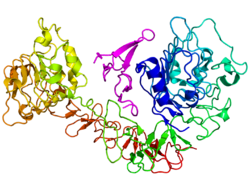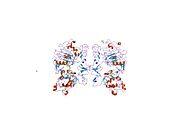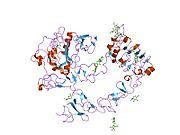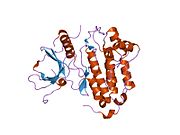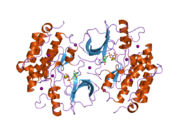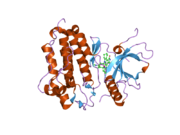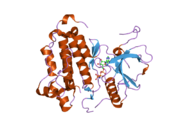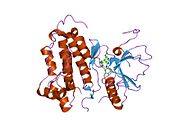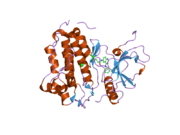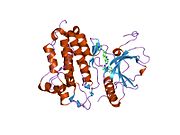Epidermal growth factor receptor
Theepidermal growth factor receptor(EGFR;ErbB-1;HER1in humans) is atransmembrane proteinthat is areceptorfor members of theepidermal growth factorfamily (EGF family) ofextracellularproteinligands.[5]
The epidermal growth factor receptor is a member of theErbB family of receptors,a subfamily of four closely relatedreceptor tyrosine kinases:EGFR (ErbB-1),HER2/neu(ErbB-2),Her 3(ErbB-3) andHer 4(ErbB-4). In many cancer types, mutations affecting EGFR expression or activity could result incancer.[6]
Epidermal growth factor and its receptor was discovered byStanley CohenofVanderbilt University.Cohen shared the 1986Nobel Prize in MedicinewithRita Levi-Montalcinifor their discovery ofgrowth factors.
Deficient signaling of the EGFR and otherreceptor tyrosine kinasesin humans is associated with diseases such as Alzheimer's, while over-expression is associated with the development of a wide variety of tumors. Interruption of EGFR signalling, either by blocking EGFR binding sites on the extracellular domain of the receptor or by inhibiting intracellular tyrosine kinase activity, can prevent the growth of EGFR-expressing tumours and improve the patient's condition[citation needed].
Function
[edit]

Epidermal growth factor receptor (EGFR) is atransmembrane proteinthat is activated by binding of its specificligands,includingepidermal growth factorandtransforming growth factor Alpha(TGF-α).[7]ErbB2 has no known direct activatingligand,and may be in an activated state constitutively or become active uponheterodimerizationwith other family members such as EGFR. Upon activation by its growth factor ligands, EGFR undergoes a transition from an inactivemonomericform to an activehomodimer.[8]– although there is some evidence that preformed inactive dimers may also exist before ligand binding.[9]In addition to forming homodimers after ligand binding, EGFR may pair with another member of the ErbB receptor family, such asErbB2/Her2/neu,to create an activatedheterodimer.There is also evidence to suggest that clusters of activated EGFRs form, although it remains unclear whether this clustering is important for activation itself or occurs subsequent to activation of individual dimers.[10]
EGFR dimerization stimulates its intrinsic intracellular protein-tyrosine kinase activity. As a result,autophosphorylationof severaltyrosine(Y) residues in the C-terminaldomainof EGFR occurs. These include Y992, Y1045, Y1068, Y1148 and Y1173, as shown in the adjacent diagram.[11]This autophosphorylation elicits downstream activation and signaling by several other proteins that associate with the phosphorylated tyrosines through their own phosphotyrosine-bindingSH2 domains.These downstream signaling proteins initiate severalsignal transductioncascades, principally theMAPK,AktandJNKpathways, leading toDNA synthesisand cell proliferation.[12]Such proteins modulate phenotypes such ascell migration,adhesion,andproliferation.Activation of the receptor is important for the innate immune response in human skin. Additionally, the kinase domain of the EGFR can cross-phosphorylate the tyrosine residues of other receptors with which it is aggregated and thereby activate itself.
Biological roles
[edit]The EGFR is essential forductaldevelopment of themammary glands,[13][14][15]andagonistsof the EGFR such asamphiregulin,TGF-α,and heregulin induce both ductal andlobuloalveolardevelopment even in the absence ofestrogenandprogesterone.[16][17]
Role in human disease
[edit]Cancer
[edit]Mutationsthat lead to EGFR overexpression (known as upregulation or amplification) have been associated with a number ofcancers,includingadenocarcinoma of the lung(40% of cases),anal cancers,[18]glioblastoma(50%) andepithelian tumors of the head and neck(80–100%).[19]These somatic mutations involving EGFR lead to its constant activation, which produces uncontrolled cell division.[20]Inglioblastomaa specific mutation of EGFR, calledEGFRvIII,is often observed.[21]Mutations, amplifications or misregulations of EGFR or family members are implicated in about 30% of allepithelialcancers.[22]
Inflammatory disease
[edit]Aberrant EGFR signaling has been implicated in psoriasis, eczema and atherosclerosis.[23][24]However, its exact roles in these conditions are ill-defined.
Monogenic disease
[edit]A single child displaying multi-organ epithelial inflammation was found to have a homozygous loss of function mutation in theEGFRgene. The pathogenicity of the EGFR mutation was supported by in vitro experiments and functional analysis of a skin biopsy. His severe phenotype reflects many previous research findings into EGFR function. His clinical features included a papulopustular rash, dry skin, chronic diarrhoea, abnormalities of hair growth, breathing difficulties and electrolyte imbalances.[25]
Wound healing and fibrosis
[edit]EGFR has been shown to play a critical role inTGF-beta1dependentfibroblasttomyofibroblastdifferentiation.[26][27]Aberrant persistence ofmyofibroblastswithin tissues can lead to progressive tissuefibrosis,impairing tissue or organ function (e.g. skinhypertrophicorkeloidscars,liver cirrhosis,myocardial fibrosis,chronic kidney disease).
Medical applications
[edit]Drug target
[edit]The identification of EGFR as anoncogenehas led to the development of anticancer therapeutics directed against EGFR (called "EGFR inhibitors", EGFRi), includinggefitinib,[28]erlotinib,[29]afatinib,brigatinibandicotinib[30][31]for lung cancer, andcetuximabforcolon cancer.More recently AstraZeneca has developedOsimertinib,a third generation tyrosine kinase inhibitor.[32][31]
Many therapeutic approaches are aimed at the EGFR. Cetuximab andpanitumumabare examples ofmonoclonal antibodyinhibitors.However the former is of theIgG1type, the latter of theIgG2type; consequences onantibody-dependent cellular cytotoxicitycan be quite different.[33]Other monoclonals in clinical development arezalutumumab,nimotuzumab,andmatuzumab.The monoclonal antibodies block the extracellular ligand binding domain. With the binding site blocked, signal molecules can no longer attach there and activate the tyrosine kinase.
Another method is using small molecules to inhibit the EGFR tyrosine kinase, which is on the cytoplasmic side of the receptor. Without kinase activity, EGFR is unable to activate itself, which is a prerequisite for binding of downstream adaptor proteins. Ostensibly by halting the signaling cascade in cells that rely on this pathway for growth, tumor proliferation and migration is diminished.Gefitinib,erlotinib,brigatinibandlapatinib(mixed EGFR and ERBB2 inhibitor) are examples of small moleculekinaseinhibitors.
CimaVax-EGF,an activevaccinetargeting EGF as the majorligandof EGF, uses a different approach, raisingantibodiesagainst EGF itself, thereby denying EGFR-dependent cancers of a proliferative stimulus;[34]it is in use as a cancer therapy againstnon-small-cell lung carcinoma(the most common form of lung cancer) in Cuba, and is undergoing further trials for possible licensing in Japan, Europe, and the United States.[35]
There are several quantitative methods available that use protein phosphorylation detection to identify EGFR family inhibitors.[36]
New drugs such asosimertinib,gefitinib,erlotinibandbrigatinibdirectly target the EGFR. Patients have been divided into EGFR-positive and EGFR-negative, based upon whether a tissue test shows a mutation. EGFR-positive patients have shown a 60% response rate, which exceeds the response rate for conventional chemotherapy.[37]
However, many patients develop resistance. Two primary sources of resistance are the T790M mutation andMEToncogene.[37]However, as of 2010 there was no consensus of an accepted approach to combat resistance nor FDA approval of a specific combination. Clinical trial phase II results reported forbrigatinibtargeting the T790M mutation, and brigatinib received Breakthrough Therapy designation status by FDA in Feb. 2015.
The most commonadverse effectof EGFR inhibitors, found in more than 90% of patients, is apapulopustularrash that spreads across the face and torso; the rash's presence is correlated with the drug's antitumor effect.[38]In 10% to 15% of patients the effects can be serious and require treatment.[39][40]
Some tests are aiming at predicting benefit from EGFR treatment, asVeristrat.[41]
Laboratory research using genetically engineered stem cells to target EGFR in mice was reported in 2014 to show promise.[42]EGFR is a well-established target for monoclonal antibodies and specific tyrosine kinase inhibitors.[43]
Target for imaging agents
[edit]Imaging agents have been developed which identify EGFR-dependent cancers using labeled EGF.[44]The feasibility of in vivo imaging of EGFR expression has been demonstrated in several studies.[45][46]
It has been proposed that certain computed tomography findings such as ground-glass opacities, air bronchogram, spiculated margins, vascular convergence, and pleural retraction can predict the presence of EGFR mutation in patients with non-small cell lung cancer.[47]
Interactions
[edit]Epidermal growth factor receptor has been shown tointeractwith:
- AR,[48][49]
- ARF4,[50]
- CAV1,[51]
- CAV3,[51]
- CBL,[52][53][54][55][56]
- CBLB,[53][57]
- CBLC,[58][59]
- CD44,[26]
- CDC25A,[60]
- CRK,[57][61]
- CTNNB1,[62][63][64]
- DCN,[65][66]
- EGF,[67][68]
- GRB14,[69]
- Grb2,[57][67][69][70][71][72][73][74][75][76]
- JAK2,[77]
- MUC1,[78][79]
- NCK1,[70][80][81]
- NCK2[70][82][83]
- PKC Alpha,[84]
- PLCG1,[52][85]
- PLSCR1,[86]
- PTPN1,[87][88]
- PTPN11,[57][89]
- PTPN6,[89][90]
- PTPRK,[91]
- SH2D3A,[92]
- SH3KBP1,[93][94]
- SHC1,[57][95]
- SOS1,[75][96][97]
- Src,[77][98][99]
- STAT1,[77][100]
- STAT3,[77][101]
- STAT5A,[57][77]
- UBC,[54][55][102]and
- WAS,[103]
- PAR2.[104]
In fruitflies, theepidermal growth factor receptorinteracts withSpitz.[105]
References
[edit]- ^abcGRCh38: Ensembl release 89: ENSG00000146648–Ensembl,May 2017
- ^abcGRCm38: Ensembl release 89: ENSMUSG00000020122–Ensembl,May 2017
- ^"Human PubMed Reference:".National Center for Biotechnology Information, U.S. National Library of Medicine.
- ^"Mouse PubMed Reference:".National Center for Biotechnology Information, U.S. National Library of Medicine.
- ^Herbst RS (2004)."Review of epidermal growth factor receptor biology".International Journal of Radiation Oncology, Biology, Physics.59(2 Suppl): 21–6.doi:10.1016/j.ijrobp.2003.11.041.PMID15142631.
- ^Zhang H, Berezov A, Wang Q, Zhang G, Drebin J, Murali R, Greene MI (August 2007)."ErbB receptors: from oncogenes to targeted cancer treatment".The Journal of Clinical Investigation.117(8): 2051–8.doi:10.1172/JCI32278.PMC1934579.PMID17671639.
- ^note, a full list of the ligands able to activate EGFR and other members of the ErbB family is given in theErbBarticle)
- ^Yarden Y, Schlessinger J (March 1987). "Epidermal growth factor induces rapid, reversible aggregation of the purified epidermal growth factor receptor".Biochemistry.26(5): 1443–51.doi:10.1021/bi00379a035.PMID3494473.
- ^Maruyama IN (April 2014)."Mechanisms of activation of receptor tyrosine kinases: monomers or dimers".Cells.3(2): 304–30.doi:10.3390/cells3020304.PMC4092861.PMID24758840.
- ^Abulrob A, Lu Z, Baumann E, Vobornik D, Taylor R, Stanimirovic D, Johnston LJ (January 2010)."Nanoscale imaging of epidermal growth factor receptor clustering: effects of inhibitors".The Journal of Biological Chemistry.285(5): 3145–3156.doi:10.1074/jbc.M109.073338.PMC2823441.PMID19959837.
- ^Downward J, Parker P, Waterfield MD (1984). "Autophosphorylation sites on the epidermal growth factor receptor".Nature.311(5985): 483–5.Bibcode:1984Natur.311..483D.doi:10.1038/311483a0.PMID6090945.S2CID4332354.
- ^Oda K, Matsuoka Y, Funahashi A, Kitano H (2005)."A comprehensive pathway map of epidermal growth factor receptor signaling".Molecular Systems Biology.1(1): E1–E17.doi:10.1038/msb4100014.PMC1681468.PMID16729045.
- ^Sebastian J, Richards RG, Walker MP, Wiesen JF, Werb Z, Derynck R, Hom YK, Cunha GR, DiAugustine RP (September 1998). "Activation and function of the epidermal growth factor receptor and erbB-2 during mammary gland morphogenesis".Cell Growth & Differentiation.9(9): 777–85.PMID9751121.
- ^McBryan J, Howlin J, Napoletano S, Martin F (June 2008). "Amphiregulin: role in mammary gland development and breast cancer".Journal of Mammary Gland Biology and Neoplasia.13(2): 159–69.doi:10.1007/s10911-008-9075-7.PMID18398673.S2CID13229645.
- ^Sternlicht MD, Sunnarborg SW (June 2008)."The ADAM17-amphiregulin-EGFR axis in mammary development and cancer".Journal of Mammary Gland Biology and Neoplasia.13(2): 181–94.doi:10.1007/s10911-008-9084-6.PMC2723838.PMID18470483.
- ^Kenney NJ, Bowman A, Korach KS, Barrett JC, Salomon DS (May 2003). "Effect of exogenous epidermal-like growth factors on mammary gland development and differentiation in the estrogen receptor- Alpha knockout (ERKO) mouse".Breast Cancer Research and Treatment.79(2): 161–73.doi:10.1023/a:1023938510508.PMID12825851.S2CID30782707.
- ^Kenney NJ, Smith GH, Rosenberg K, Cutler ML, Dickson RB (December 1996). "Induction of ductal morphogenesis and lobular hyperplasia by amphiregulin in the mouse mammary gland".Cell Growth & Differentiation.7(12): 1769–81.PMID8959346.
- ^Walker F, Abramowitz L, Benabderrahmane D, Duval X, Descatoire V, Hénin D, et al. (November 2009)."Growth factor receptor expression in anal squamous lesions: modifications associated with oncogenic human papillomavirus and human immunodeficiency virus".Human Pathology.40(11): 1517–27.doi:10.1016/j.humpath.2009.05.010.PMID19716155.
- ^Kumar V, Abbas A, Aster J (2013).Robbins basic pathology.Philadelphia: Elsevier/Saunders. p. 179.ISBN9781437717815.
- ^Lynch TJ, Bell DW, Sordella R, Gurubhagavatula S, Okimoto RA, Brannigan BW, et al. (May 2004)."Activating mutations in the epidermal growth factor receptor underlying responsiveness of non-small-cell lung cancer to gefitinib"(PDF).The New England Journal of Medicine.350(21): 2129–39.doi:10.1056/NEJMoa040938.PMID15118073.
- ^Kuan CT, Wikstrand CJ, Bigner DD (June 2001)."EGF mutant receptor vIII as a molecular target in cancer therapy".Endocrine-Related Cancer.8(2): 83–96.doi:10.1677/erc.0.0080083.PMID11397666.S2CID11790891.
- ^Zhen Y, Guanghui L, Xiefu Z (November 2014)."Knockdown of EGFR inhibits growth and invasion of gastric cancer cells".Cancer Gene Therapy.21(11): 491–7.doi:10.1038/cgt.2014.55.PMID25394504.
- ^Jost M, Kari C, Rodeck U (2000). "The EGF receptor – an essential regulator of multiple epidermal functions".European Journal of Dermatology.10(7): 505–10.PMID11056418.
- ^Dreux AC, Lamb DJ, Modjtahedi H, Ferns GA (May 2006). "The epidermal growth factor receptors and their family of ligands: their putative role in atherogenesis".Atherosclerosis.186(1): 38–53.doi:10.1016/j.atherosclerosis.2005.06.038.PMID16076471.
- ^Campbell P, Morton PE, Takeichi T, Salam A, Roberts N, Proudfoot LE, Mellerio JE, Aminu K, Wellington C, Patil SN, Akiyama M, Liu L, McMillan JR, Aristodemou S, Ishida-Yamamoto A, Abdul-Wahab A, Petrof G, Fong K, Harnchoowong S, Stone KL, Harper JI, McLean WH, Simpson MA, Parsons M, McGrath JA (October 2014)."Epithelial inflammation resulting from an inherited loss-of-function mutation in EGFR".The Journal of Investigative Dermatology.134(10): 2570–8.doi:10.1038/jid.2014.164.PMC4090136.PMID24691054.
- ^abMidgley AC, Rogers M, Hallett MB, Clayton A, Bowen T, Phillips AO, Steadman R (May 2013)."Transforming growth factor-β1 (TGF-β1)-stimulated fibroblast to myofibroblast differentiation is mediated by hyaluronan (HA)-facilitated epidermal growth factor receptor (EGFR) and CD44 co-localization in lipid rafts".The Journal of Biological Chemistry.288(21): 14824–38.doi:10.1074/jbc.M113.451336.PMC3663506.PMID23589287.
- ^Midgley AC, Bowen T, Phillips AO, Steadman R (April 2014)."MicroRNA-7 inhibition rescues age-associated loss of epidermal growth factor receptor and hyaluronan-dependent differentiation in fibroblasts".Aging Cell.13(2): 235–44.doi:10.1111/acel.12167.PMC4331777.PMID24134702.
- ^Paez JG, Jänne PA, Lee JC, Tracy S, Greulich H, Gabriel S, et al. (June 2004)."EGFR mutations in lung cancer: correlation with clinical response to gefitinib therapy".Science.304(5676): 1497–1500.Bibcode:2004Sci...304.1497P.doi:10.1126/science.1099314.PMID15118125.
- ^Gijtenbeek RG, van der Noort V, Aerts JG, Staal-van den Brekel JA, Smit EF, Krouwels FH, et al. (October 2022)."Randomised controlled trial of first-line tyrosine-kinase inhibitor (TKI)versusintercalated TKI with chemotherapy forEGFR-mutated nonsmall cell lung cancer ".ERJ Open Research.8(4): 00239–2022.doi:10.1183/23120541.00239-2022.PMC9574558.PMID36267895.
- ^Liang W, Wu X, Fang W, Zhao Y, Yang Y, Hu Z, et al. (12 February 2014)."Network meta-analysis of erlotinib, gefitinib, afatinib and icotinib in patients with advanced non-small-cell lung cancer harboring EGFR mutations".PLOS ONE.9(2): e85245.Bibcode:2014PLoSO...985245L.doi:10.1371/journal.pone.0085245.PMC3922700.PMID24533047.
- ^abGijtenbeek RG, Damhuis RA, van der Wekken AJ, Hendriks LE, Groen HJ, van Geffen WH (April 2023)."Overall survival in advanced epidermal growth factor receptor mutated non-small cell lung cancer using different tyrosine kinase inhibitors in The Netherlands: a retrospective, nationwide registry study".The Lancet Regional Health. Europe.27:100592.doi:10.1016/j.lanepe.2023.100592.PMC9932646.PMID36817181.
- ^Greig SL (February 2016). "Osimertinib: First Global Approval".Drugs.76(2): 263–273.doi:10.1007/s40265-015-0533-4.PMID26729184.S2CID45076898.
- ^Yan L, Beckman RA (October 2005)."Pharmacogenetics and pharmacogenomics in oncology therapeutic antibody development".BioTechniques.39(4): 565–8.doi:10.2144/000112043.PMID16235569.
- ^Rodríguez PC, Rodríguez G, González G, Lage A (Winter 2010)."Clinical development and perspectives of CIMAvax EGF, Cuban vaccine for non-small-cell lung cancer therapy".MEDICC Review.12(1): 17–23.doi:10.37757/MR2010.V12.N1.4.PMID20387330.
- ^Patel N (11 May 2015)."Cuba Has a Lung Cancer Vaccine—And America Wants It".Wired.Retrieved13 May2015.
- ^Olive DM (October 2004). "Quantitative methods for the analysis of protein phosphorylation in drug development".Expert Review of Proteomics.1(3): 327–41.doi:10.1586/14789450.1.3.327.PMID15966829.S2CID30003827.
- ^abJackman DM, Miller VA, Cioffredi LA, Yeap BY, Jänne PA, Riely GJ, Ruiz MG, Giaccone G, Sequist LV, Johnson BE (August 2009)."Impact of epidermal growth factor receptor and KRAS mutations on clinical outcomes in previously untreated non-small cell lung cancer patients: results of an online tumor registry of clinical trials".Clinical Cancer Research.15(16): 5267–73.doi:10.1158/1078-0432.CCR-09-0888.PMC3219530.PMID19671843.
- ^Liu HB, Wu Y, Lv TF, Yao YW, Xiao YY, Yuan DM, Song Y (2013)."Skin rash could predict the response to EGFR tyrosine kinase inhibitor and the prognosis for patients with non-small cell lung cancer: a systematic review and meta-analysis".PLOS ONE.8(1): e55128.Bibcode:2013PLoSO...855128L.doi:10.1371/journal.pone.0055128.PMC3559430.PMID23383079.
- ^Gerber PA, Meller S, Eames T, Buhren BA, Schrumpf H, Hetzer S, Ehmann LM, Budach W, Bölke E, Matuschek C, Wollenberg A, Homey B (2012)."Management of EGFR-inhibitor associated rash: a retrospective study in 49 patients".European Journal of Medical Research.17(1): 4.doi:10.1186/2047-783X-17-4.PMC3351712.PMID22472354.
- ^Lacouture ME (October 2006). "Mechanisms of cutaneous toxicities to EGFR inhibitors".Nature Reviews. Cancer.6(10): 803–12.doi:10.1038/nrc1970.PMID16990857.S2CID7782594.
- ^Molina-Pinelo S, Pastor MD, Paz-Ares L (February 2014)."VeriStrat: a prognostic and/or predictive biomarker for advanced lung cancer patients?".Expert Review of Respiratory Medicine.8(1): 1–4.doi:10.1586/17476348.2014.861744.PMID24308656.S2CID44854672.
- ^Stuckey DW, Hingtgen SD, Karakas N, Rich BE, Shah K (February 2015)."Engineering toxin-resistant therapeutic stem cells to treat brain tumors".Stem Cells.33(2): 589–600.doi:10.1002/stem.1874.PMC4305025.PMID25346520.
- ^Roskoski Jr R (January 2014). "The ErbB/HER family of protein-tyrosine kinases and cancer".Pharmacological Research.79:34–74.doi:10.1016/j.phrs.2013.11.002.PMID24269963.
- ^Lucas LJ, Tellez CA, Castilho ML, Lee CL, Hupman MA, Vieira LS, Ferreira I, Raniero L, Hewitt KC (May 2015). "Development of a sensitive, stable and EGFR-specific molecular imaging agent for surface enhanced Raman spectroscopy".Journal of Raman Spectroscopy.46(5): 434–446.Bibcode:2015JRSp...46..434L.doi:10.1002/jrs.4678.
- ^Lucas LJ, Chen XK, Smith AJ, Korbelik M, Zeng, Haitian L, Lee PW, Hewitt KC (23 January 2015)."Aggregation of nanoparticles in endosomes and lysosomes produces surface-enhanced Raman spectroscopy".Journal of Nanophotonics.9(1): 093094–1–14.Bibcode:2015JNano...9.3094L.doi:10.1117/1.JNP.9.093094.
- ^Andersson KG, Oroujeni M, Garousi J, Mitran B, Ståhl S, Orlova A, Löfblom J, Tolmachev V (December 2016)."Feasibility of imaging of epidermal growth factor receptor expression with ZEGFR:2377 affibody molecule labeled with 99mTc using a peptide-based cysteine-containing chelator".International Journal of Oncology.49(6): 2285–2293.doi:10.3892/ijo.2016.3721.PMC5118000.PMID27748899.
- ^Herrera Ortiz AF, Cadavid Camacho T, Vásquez Perdomo A, Castillo Herazo V, Arambula Neira J, Yepes Bustamante M, Cadavid Camacho E. Clinical and CT patterns to predict EGFR mutation in patients with non-small cell lung cancer: A systematic literature review and meta-analysis. European Journal of Radiology Open.2022;9:100400.https://doi.org/10.1016/j.ejro.2022.100400
- ^Bonaccorsi L, Carloni V, Muratori M, Formigli L, Zecchi S, Forti G, Baldi E (October 2004). "EGF receptor (EGFR) signaling promoting invasion is disrupted in androgen-sensitive prostate cancer cells by an interaction between EGFR and androgen receptor (AR)".International Journal of Cancer.112(1): 78–86.doi:10.1002/ijc.20362.hdl:2158/395766.PMID15305378.S2CID46121331.
- ^Bonaccorsi L, Muratori M, Carloni V, Marchiani S, Formigli L, Forti G, Baldi E (August 2004). "The androgen receptor associates with the epidermal growth factor receptor in androgen-sensitive prostate cancer cells".Steroids.69(8–9): 549–52.doi:10.1016/j.steroids.2004.05.011.hdl:2158/395763.PMID15288768.S2CID23831527.
- ^Kim SW, Hayashi M, Lo JF, Yang Y, Yoo JS, Lee JD (January 2003)."ADP-ribosylation factor 4 small GTPase mediates epidermal growth factor receptor-dependent phospholipase D2 activation".The Journal of Biological Chemistry.278(4): 2661–8.doi:10.1074/jbc.M205819200.PMID12446727.
- ^abCouet J, Sargiacomo M, Lisanti MP (November 1997)."Interaction of a receptor tyrosine kinase, EGF-R, with caveolins. Caveolin binding negatively regulates tyrosine and serine/threonine kinase activities".The Journal of Biological Chemistry.272(48): 30429–38.doi:10.1074/jbc.272.48.30429.PMID9374534.
- ^abTvorogov D, Carpenter G (July 2002). "EGF-dependent association of phospholipase C-gamma1 with c-Cbl".Experimental Cell Research.277(1): 86–94.doi:10.1006/excr.2002.5545.PMID12061819.
- ^abEttenberg SA, Keane MM, Nau MM, Frankel M, Wang LM, Pierce JH, Lipkowitz S (March 1999)."cbl-b inhibits epidermal growth factor receptor signaling".Oncogene.18(10): 1855–66.doi:10.1038/sj.onc.1202499.PMID10086340.
- ^abPennock S, Wang Z (May 2008)."A tale of two Cbls: interplay of c-Cbl and Cbl-b in epidermal growth factor receptor downregulation".Molecular and Cellular Biology.28(9): 3020–37.doi:10.1128/MCB.01809-07.PMC2293090.PMID18316398.
- ^abUmebayashi K, Stenmark H, Yoshimori T (August 2008)."Ubc4/5 and c-Cbl continue to ubiquitinate EGF receptor after internalization to facilitate polyubiquitination and degradation".Molecular Biology of the Cell.19(8): 3454–62.doi:10.1091/mbc.E07-10-0988.PMC2488299.PMID18508924.
- ^Ng C, Jackson RA, Buschdorf JP, Sun Q, Guy GR, Sivaraman J (March 2008)."Structural basis for a novel intrapeptidyl H-bond and reverse binding of c-Cbl-TKB domain substrates".The EMBO Journal.27(5): 804–16.doi:10.1038/emboj.2008.18.PMC2265755.PMID18273061.
- ^abcdefSchulze WX, Deng L, Mann M (2005)."Phosphotyrosine interactome of the ErbB-receptor kinase family".Molecular Systems Biology.1(1): E1–E13.doi:10.1038/msb4100012.PMC1681463.PMID16729043.
- ^Kim M, Tezuka T, Suziki Y, Sugano S, Hirai M, Yamamoto T (October 1999). "Molecular cloning and characterization of a novel cbl-family gene, cbl-c".Gene.239(1): 145–54.doi:10.1016/S0378-1119(99)00356-X.PMID10571044.
- ^Keane MM, Ettenberg SA, Nau MM, Banerjee P, Cuello M, Penninger J, Lipkowitz S (June 1999). "cbl-3: a new mammalian cbl family protein".Oncogene.18(22): 3365–75.doi:10.1038/sj.onc.1202753.PMID10362357.S2CID28195948.
- ^Wang Z, Wang M, Lazo JS, Carr BI (May 2002)."Identification of epidermal growth factor receptor as a target of Cdc25A protein phosphatase".The Journal of Biological Chemistry.277(22): 19470–5.doi:10.1074/jbc.M201097200.PMID11912208.
- ^Hashimoto Y, Katayama H, Kiyokawa E, Ota S, Kurata T, Gotoh N, Otsuka N, Shibata M, Matsuda M (July 1998)."Phosphorylation of CrkII adaptor protein at tyrosine 221 by epidermal growth factor receptor".The Journal of Biological Chemistry.273(27): 17186–91.doi:10.1074/jbc.273.27.17186.PMID9642287.
- ^Hazan RB, Norton L (April 1998)."The epidermal growth factor receptor modulates the interaction of E-cadherin with the actin cytoskeleton".The Journal of Biological Chemistry.273(15): 9078–84.doi:10.1074/jbc.273.15.9078.PMID9535896.
- ^Schroeder JA, Adriance MC, McConnell EJ, Thompson MC, Pockaj B, Gendler SJ (June 2002)."ErbB-beta-catenin complexes are associated with human infiltrating ductal breast and murine mammary tumor virus (MMTV)-Wnt-1 and MMTV-c-Neu transgenic carcinomas".The Journal of Biological Chemistry.277(25): 22692–8.doi:10.1074/jbc.M201975200.PMID11950845.
- ^Takahashi K, Suzuki K, Tsukatani Y (July 1997). "Induction of tyrosine phosphorylation and association of beta-catenin with EGF receptor upon tryptic digestion of quiescent cells at confluence".Oncogene.15(1): 71–8.doi:10.1038/sj.onc.1201160.PMID9233779.S2CID10127053.
- ^Santra M, Reed CC, Iozzo RV (September 2002)."Decorin binds to a narrow region of the epidermal growth factor (EGF) receptor, partially overlapping but distinct from the EGF-binding epitope".The Journal of Biological Chemistry.277(38): 35671–81.doi:10.1074/jbc.M205317200.PMID12105206.
- ^Iozzo RV, Moscatello DK, McQuillan DJ, Eichstetter I (February 1999)."Decorin is a biological ligand for the epidermal growth factor receptor".The Journal of Biological Chemistry.274(8): 4489–92.doi:10.1074/jbc.274.8.4489.PMID9988678.
- ^abWong L, Deb TB, Thompson SA, Wells A, Johnson GR (March 1999)."A differential requirement for the COOH-terminal region of the epidermal growth factor (EGF) receptor in amphiregulin and EGF mitogenic signaling".The Journal of Biological Chemistry.274(13): 8900–9.doi:10.1074/jbc.274.13.8900.PMID10085134.
- ^Stortelers C, Souriau C, van Liempt E, van de Poll ML, van Zoelen EJ (July 2002). "Role of the N-terminus of epidermal growth factor in ErbB-2/ErbB-3 binding studied by phage display".Biochemistry.41(27): 8732–41.doi:10.1021/bi025878c.PMID12093292.
- ^abDaly RJ, Sanderson GM, Janes PW, Sutherland RL (May 1996)."Cloning and characterization of GRB14, a novel member of the GRB7 gene family".The Journal of Biological Chemistry.271(21): 12502–10.doi:10.1074/jbc.271.21.12502.PMID8647858.
- ^abcBraverman LE, Quilliam LA (February 1999)."Identification of Grb4/Nckbeta, a src homology 2 and 3 domain-containing adapter protein having similar binding and biological properties to Nck".The Journal of Biological Chemistry.274(9): 5542–9.doi:10.1074/jbc.274.9.5542.PMID10026169.
- ^Blagoev B, Kratchmarova I, Ong SE, Nielsen M, Foster LJ, Mann M (March 2003). "A proteomics strategy to elucidate functional protein-protein interactions applied to EGF signaling".Nature Biotechnology.21(3): 315–8.doi:10.1038/nbt790.PMID12577067.S2CID26838266.
- ^Oneyama C, Nakano H, Sharma SV (March 2002). "UCS15A, a novel small molecule, SH3 domain-mediated protein-protein interaction blocking drug".Oncogene.21(13): 2037–50.doi:10.1038/sj.onc.1205271.PMID11960376.S2CID23869665.
- ^Okutani T, Okabayashi Y, Kido Y, Sugimoto Y, Sakaguchi K, Matuoka K, Takenawa T, Kasuga M (December 1994)."Grb2/Ash binds directly to tyrosines 1068 and 1086 and indirectly to tyrosine 1148 of activated human epidermal growth factor receptors in intact cells".The Journal of Biological Chemistry.269(49): 31310–4.doi:10.1016/S0021-9258(18)47424-8.hdl:20.500.14094/D2001922.PMID7527043.
- ^Tortora G, Damiano V, Bianco C, Baldassarre G, Bianco AR, Lanfrancone L, Pelicci PG, Ciardiello F (February 1997). "The RI Alpha subunit of protein kinase A (PKA) binds to Grb2 and allows PKA interaction with the activated EGF-receptor".Oncogene.14(8): 923–8.doi:10.1038/sj.onc.1200906.PMID9050991.S2CID10640461.
- ^abBuday L, Egan SE, Rodriguez Viciana P, Cantrell DA, Downward J (March 1994)."A complex of Grb2 adaptor protein, Sos exchange factor, and a 36-kDa membrane-bound tyrosine phosphoprotein is implicated in ras activation in T cells".The Journal of Biological Chemistry.269(12): 9019–23.doi:10.1016/S0021-9258(17)37070-9.PMID7510700.
- ^Lowenstein EJ, Daly RJ, Batzer AG, Li W, Margolis B, Lammers R, Ullrich A, Skolnik EY, Bar-Sagi D, Schlessinger J (August 1992)."The SH2 and SH3 domain-containing protein GRB2 links receptor tyrosine kinases to ras signaling".Cell.70(3): 431–42.doi:10.1016/0092-8674(92)90167-B.PMID1322798.
- ^abcdeOlayioye MA, Beuvink I, Horsch K, Daly JM, Hynes NE (June 1999)."ErbB receptor-induced activation of stat transcription factors is mediated by Src tyrosine kinases".The Journal of Biological Chemistry.274(24): 17209–18.doi:10.1074/jbc.274.24.17209.PMID10358079.
- ^Schroeder JA, Thompson MC, Gardner MM, Gendler SJ (April 2001)."Transgenic MUC1 interacts with epidermal growth factor receptor and correlates with mitogen-activated protein kinase activation in the mouse mammary gland".The Journal of Biological Chemistry.276(16): 13057–64.doi:10.1074/jbc.M011248200.PMID11278868.
- ^Li Y, Ren J, Yu W, Li Q, Kuwahara H, Yin L, Carraway KL, Kufe D (September 2001)."The epidermal growth factor receptor regulates interaction of the human DF3/MUC1 carcinoma antigen with c-Src and beta-catenin".The Journal of Biological Chemistry.276(38): 35239–42.doi:10.1074/jbc.C100359200.PMID11483589.
- ^Tang J, Feng GS, Li W (October 1997)."Induced direct binding of the adapter protein Nck to the GTPase-activating protein-associated protein p62 by epidermal growth factor".Oncogene.15(15): 1823–32.doi:10.1038/sj.onc.1201351.PMID9362449.
- ^Li W, Hu P, Skolnik EY, Ullrich A, Schlessinger J (December 1992)."The SH2 and SH3 domain-containing Nck protein is oncogenic and a common target for phosphorylation by different surface receptors".Molecular and Cellular Biology.12(12): 5824–33.doi:10.1128/MCB.12.12.5824.PMC360522.PMID1333047.
- ^Chen M, She H, Davis EM, Spicer CM, Kim L, Ren R, Le Beau MM, Li W (September 1998)."Identification of Nck family genes, chromosomal localization, expression, and signaling specificity".The Journal of Biological Chemistry.273(39): 25171–8.doi:10.1074/jbc.273.39.25171.PMID9737977.
- ^Tu Y, Li F, Wu C (December 1998)."Nck-2, a novel Src homology2/3-containing adaptor protein that interacts with the LIM-only protein PINCH and components of growth factor receptor kinase-signaling pathways".Molecular Biology of the Cell.9(12): 3367–82.doi:10.1091/mbc.9.12.3367.PMC25640.PMID9843575.
- ^Gauthier ML, Torretto C, Ly J, Francescutti V, O'Day DH (August 2003). "Protein kinase C Alpha negatively regulates cell spreading and motility in MDA-MB-231 human breast cancer cells downstream of epidermal growth factor receptor".Biochemical and Biophysical Research Communications.307(4): 839–46.doi:10.1016/S0006-291X(03)01273-7.PMID12878187.
- ^Bedrin MS, Abolafia CM, Thompson JF (July 1997). "Cytoskeletal association of epidermal growth factor receptor and associated signaling proteins is regulated by cell density in IEC-6 intestinal cells".Journal of Cellular Physiology.172(1): 126–36.doi:10.1002/(SICI)1097-4652(199707)172:1<126::AID-JCP14>3.0.CO;2-A.PMID9207933.S2CID24571987.
- ^Sun J, Nanjundan M, Pike LJ, Wiedmer T, Sims PJ (May 2002). "Plasma membrane phospholipid scramblase 1 is enriched in lipid rafts and interacts with the epidermal growth factor receptor".Biochemistry.41(20): 6338–45.doi:10.1021/bi025610l.PMID12009895.
- ^Sarmiento M, Puius YA, Vetter SW, Keng YF, Wu L, Zhao Y, Lawrence DS, Almo SC, Zhang ZY (July 2000). "Structural basis of plasticity in protein tyrosine phosphatase 1B substrate recognition".Biochemistry.39(28): 8171–9.doi:10.1021/bi000319w.PMID10889023.
- ^Zhang ZY, Walsh AB, Wu L, McNamara DJ, Dobrusin EM, Miller WT (March 1996)."Determinants of substrate recognition in the protein-tyrosine phosphatase, PTP1".The Journal of Biological Chemistry.271(10): 5386–92.doi:10.1074/jbc.271.10.5386.PMID8621392.
- ^abTomic S, Greiser U, Lammers R, Kharitonenkov A, Imyanitov E, Ullrich A, Böhmer FD (September 1995)."Association of SH2 domain protein tyrosine phosphatases with the epidermal growth factor receptor in human tumor cells. Phosphatidic acid activates receptor dephosphorylation by PTP1C".The Journal of Biological Chemistry.270(36): 21277–84.doi:10.1074/jbc.270.36.21277.PMID7673163.
- ^Keilhack H, Tenev T, Nyakatura E, Godovac-Zimmermann J, Nielsen L, Seedorf K, Böhmer FD (September 1998)."Phosphotyrosine 1173 mediates binding of the protein-tyrosine phosphatase SHP-1 to the epidermal growth factor receptor and attenuation of receptor signaling".The Journal of Biological Chemistry.273(38): 24839–46.doi:10.1074/jbc.273.38.24839.PMID9733788.
- ^Wang SE, Wu FY, Shin I, Qu S, Arteaga CL (June 2005)."Transforming growth factor {beta} (TGF-{beta})-Smad target gene protein tyrosine phosphatase receptor type kappa is required for TGF-{beta} function".Molecular and Cellular Biology.25(11): 4703–15.doi:10.1128/MCB.25.11.4703-4715.2005.PMC1140650.PMID15899872.
- ^Lu Y, Brush J, Stewart TA (April 1999)."NSP1 defines a novel family of adaptor proteins linking integrin and tyrosine kinase receptors to the c-Jun N-terminal kinase/stress-activated protein kinase signaling pathway".The Journal of Biological Chemistry.274(15): 10047–52.doi:10.1074/jbc.274.15.10047.PMID10187783.
- ^Soubeyran P, Kowanetz K, Szymkiewicz I, Langdon WY, Dikic I (March 2002). "Cbl-CIN85-endophilin complex mediates ligand-induced downregulation of EGF receptors".Nature.416(6877): 183–7.Bibcode:2002Natur.416..183S.doi:10.1038/416183a.PMID11894095.S2CID635702.
- ^Szymkiewicz I, Kowanetz K, Soubeyran P, Dinarina A, Lipkowitz S, Dikic I (October 2002)."CIN85 participates in Cbl-b-mediated down-regulation of receptor tyrosine kinases".The Journal of Biological Chemistry.277(42): 39666–72.doi:10.1074/jbc.M205535200.PMID12177062.
- ^Sakaguchi K, Okabayashi Y, Kido Y, Kimura S, Matsumura Y, Inushima K, Kasuga M (April 1998)."Shc phosphotyrosine-binding domain dominantly interacts with epidermal growth factor receptors and mediates Ras activation in intact cells".Molecular Endocrinology.12(4): 536–43.doi:10.1210/mend.12.4.0094.PMID9544989.
- ^Qian X, Esteban L, Vass WC, Upadhyaya C, Papageorge AG, Yienger K, Ward JM, Lowy DR, Santos E (February 2000)."The Sos1 and Sos2 Ras-specific exchange factors: differences in placental expression and signaling properties".The EMBO Journal.19(4): 642–54.doi:10.1093/emboj/19.4.642.PMC305602.PMID10675333.
- ^Qian X, Vass WC, Papageorge AG, Anborgh PH, Lowy DR (February 1998)."N terminus of Sos1 Ras exchange factor: critical roles for the Dbl and pleckstrin homology domains".Molecular and Cellular Biology.18(2): 771–8.doi:10.1128/mcb.18.2.771.PMC108788.PMID9447973.
- ^Keely SJ, Calandrella SO, Barrett KE (April 2000)."Carbachol-stimulated transactivation of epidermal growth factor receptor and mitogen-activated protein kinase in T(84) cells is mediated by intracellular Ca2+, PYK-2, and p60(src)".The Journal of Biological Chemistry.275(17): 12619–25.doi:10.1074/jbc.275.17.12619.PMID10777553.
- ^Sato K, Kimoto M, Kakumoto M, Horiuchi D, Iwasaki T, Tokmakov AA, Fukami Y (September 2000). "Adaptor protein Shc undergoes translocation and mediates up-regulation of the tyrosine kinase c-Src in EGF-stimulated A431 cells".Genes to Cells.5(9): 749–64.doi:10.1046/j.1365-2443.2000.00358.x.PMID10971656.S2CID26366427.
- ^Xia L, Wang L, Chung AS, Ivanov SS, Ling MY, Dragoi AM, Platt A, Gilmer TM, Fu XY, Chin YE (August 2002)."Identification of both positive and negative domains within the epidermal growth factor receptor COOH-terminal region for signal transducer and activator of transcription (STAT) activation".The Journal of Biological Chemistry.277(34): 30716–23.doi:10.1074/jbc.M202823200.PMID12070153.
- ^Yuan ZL, Guan YJ, Wang L, Wei W, Kane AB, Chin YE (November 2004)."Central role of the threonine residue within the p+1 loop of receptor tyrosine kinase in STAT3 constitutive phosphorylation in metastatic cancer cells".Molecular and Cellular Biology.24(21): 9390–400.doi:10.1128/MCB.24.21.9390-9400.2004.PMC522220.PMID15485908.
- ^Sehat B, Andersson S, Girnita L, Larsson O (July 2008). "Identification of c-Cbl as a new ligase for insulin-like growth factor-I receptor with distinct roles from Mdm2 in receptor ubiquitination and endocytosis".Cancer Research.68(14): 5669–77.doi:10.1158/0008-5472.CAN-07-6364.PMID18632619.
- ^She HY, Rockow S, Tang J, Nishimura R, Skolnik EY, Chen M, Margolis B, Li W (September 1997)."Wiskott-Aldrich syndrome protein is associated with the adapter protein Grb2 and the epidermal growth factor receptor in living cells".Molecular Biology of the Cell.8(9): 1709–21.doi:10.1091/mbc.8.9.1709.PMC305731.PMID9307968.
- ^Jiang Y, Lim J, Wu KC, Xu W, Suen JY, Fairlie DP (November 2020)."PAR2 induces ovarian cancer cell motility by merging three signalling pathways to transactivate EGFR".British Journal of Pharmacology.(n/a) ((n/a)): 913–932.doi:10.1111/bph.15332.ISSN0007-1188.PMID33226635.S2CID227135487.
- ^Shilo BZ (March 2003). "Signaling by the Drosophila epidermal growth factor receptor pathway during development".Experimental Cell Research.284(1): 140–9.doi:10.1016/S0014-4827(02)00094-0.PMID12648473.
Further reading
[edit]- Carpenter G (1987). "Receptors for epidermal growth factor and other polypeptide mitogens".Annual Review of Biochemistry.56(1): 881–914.doi:10.1146/annurev.bi.56.070187.004313.PMID3039909.
- Boonstra J, Rijken P, Humbel B, Cremers F, Verkleij A, van Bergen en Henegouwen P (May 1995). "The epidermal growth factor".Cell Biology International.19(5): 413–30.doi:10.1006/cbir.1995.1086.PMID7640657.S2CID20186286.
- Carpenter G (August 2000). "The EGF receptor: a nexus for trafficking and signaling".BioEssays.22(8): 697–707.doi:10.1002/1521-1878(200008)22:8<697::AID-BIES3>3.0.CO;2-1.PMID10918300.S2CID767308.
- Filardo EJ (February 2002). "Epidermal growth factor receptor (EGFR) transactivation by estrogen via the G-protein-coupled receptor, GPR30: a novel signaling pathway with potential significance for breast cancer".The Journal of Steroid Biochemistry and Molecular Biology.80(2): 231–8.doi:10.1016/S0960-0760(01)00190-X.PMID11897506.S2CID34995614.
- Tiganis T (January 2002)."Protein tyrosine phosphatases: dephosphorylating the epidermal growth factor receptor".IUBMB Life.53(1): 3–14.doi:10.1080/15216540210811.PMID12018405.S2CID8376444.
- Di Fiore PP, Scita G (October 2002). "Eps8 in the midst of GTPases".The International Journal of Biochemistry & Cell Biology.34(10): 1178–83.doi:10.1016/S1357-2725(02)00064-X.PMID12127568.
- Benaim G, Villalobo A (August 2002)."Phosphorylation of calmodulin. Functional implications"(PDF).European Journal of Biochemistry.269(15): 3619–31.doi:10.1046/j.1432-1033.2002.03038.x.hdl:10261/79981.PMID12153558.
- Leu TH, Maa MC (January 2003)."Functional implication of the interaction between EGF receptor and c-Src".Frontiers in Bioscience.8(1–3): s28–38.doi:10.2741/980.PMID12456372.S2CID20827945.
- Anderson NL, Anderson NG (November 2002)."The human plasma proteome: history, character, and diagnostic prospects".Molecular & Cellular Proteomics.1(11): 845–67.doi:10.1074/mcp.R200007-MCP200.PMID12488461.
- Kari C, Chan TO, Rocha de Quadros M, Rodeck U (January 2003). "Targeting the epidermal growth factor receptor in cancer: apoptosis takes center stage".Cancer Research.63(1): 1–5.PMID12517767.
- Bonaccorsi L, Muratori M, Carloni V, Zecchi S, Formigli L, Forti G, Baldi E (February 2003). "Androgen receptor and prostate cancer invasion".International Journal of Andrology.26(1): 21–5.doi:10.1046/j.1365-2605.2003.00375.x.hdl:2158/252370.PMID12534934.
- Reiter J, Maihle NJ (May 2003). "Characterization and expression of novel 60-kDa and 110-kDa EGFR isoforms in human placenta".Annals of the New York Academy of Sciences.995(1): 39–47.Bibcode:2003NYASA.995...39R.doi:10.1111/j.1749-6632.2003.tb03208.x.PMID12814937.S2CID9377682.
- Adams TE, McKern NM, Ward CW (June 2004). "Signalling by the type 1 insulin-like growth factor receptor: interplay with the epidermal growth factor receptor".Growth Factors.22(2): 89–95.doi:10.1080/08977190410001700998.PMID15253384.S2CID86844427.
- Ferguson KM (November 2004). "Active and inactive conformations of the epidermal growth factor receptor".Biochemical Society Transactions.32(Pt 5): 742–5.doi:10.1042/BST0320742.PMID15494003.
- Chao C, Hellmich MR (December 2004). "Bi-directional signaling between gastrointestinal peptide hormone receptors and epidermal growth factor receptor".Growth Factors.22(4): 261–8.doi:10.1080/08977190412331286900.PMID15621729.S2CID35208079.
- Carlsson J, Ren ZP, Wester K, Sundberg AL, Heldin NE, Hesselager G, Persson M, Gedda L, Tolmachev V, Lundqvist H, Blomquist E, Nistér M (March 2006). "Planning for intracavitary anti-EGFR radionuclide therapy of gliomas. Literature review and data on EGFR expression".Journal of Neuro-Oncology.77(1): 33–45.doi:10.1007/s11060-005-7410-z.PMID16200342.S2CID42293693.
- Scartozzi M, Pierantoni C, Berardi R, Antognoli S, Bearzi I, Cascinu S (April 2006). "Epidermal growth factor receptor: a promising therapeutic target for colorectal cancer".Analytical and Quantitative Cytology and Histology.28(2): 61–8.PMID16637508.
- Prudkin L, Wistuba II (October 2006). "Epidermal growth factor receptor abnormalities in lung cancer. Pathogenetic and clinical implications".Annals of Diagnostic Pathology.10(5): 306–15.doi:10.1016/j.anndiagpath.2006.06.011.PMID16979526.
- Ahmed SM, Salgia R (November 2006). "Epidermal growth factor receptor mutations and susceptibility to targeted therapy in lung cancer".Respirology.11(6): 687–92.doi:10.1111/j.1440-1843.2006.00887.x.PMID17052295.S2CID38429131.
- Zhang X, Chang A (March 2007)."Somatic mutations of the epidermal growth factor receptor and non-small-cell lung cancer".Journal of Medical Genetics.44(3): 166–72.doi:10.1136/jmg.2006.046102.PMC2598028.PMID17158592.
- Mellinghoff IK,Cloughesy TF,Mischel PS(January 2007). "PTEN-mediated resistance to epidermal growth factor receptor kinase inhibitors".Clinical Cancer Research.13(2 Pt 1): 378–81.doi:10.1158/1078-0432.CCR-06-1992.PMID17255257.S2CID15077838.
- Nakamura JL (April 2007). "The epidermal growth factor receptor in malignant gliomas: pathogenesis and therapeutic implications".Expert Opinion on Therapeutic Targets.11(4): 463–72.doi:10.1517/14728222.11.4.463.PMID17373877.S2CID21947310.
External links
[edit]- Epidermal Growth Factor Receptorat the U.S. National Library of MedicineMedical Subject Headings(MeSH)
- Overview of all the structural information available in thePDBforUniProt:P00533(Human Epidermal growth factor receptor) at thePDBe-KB.

